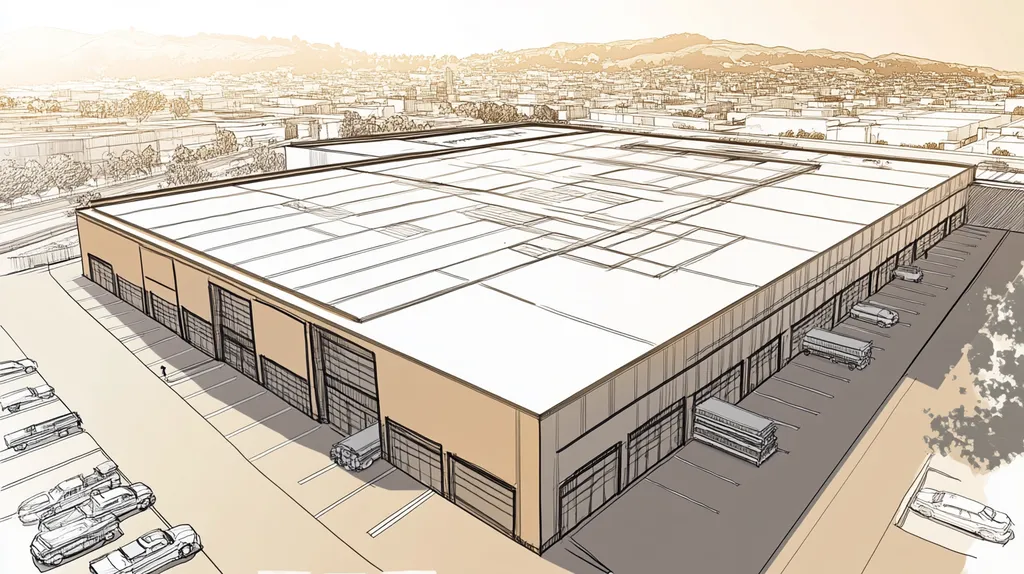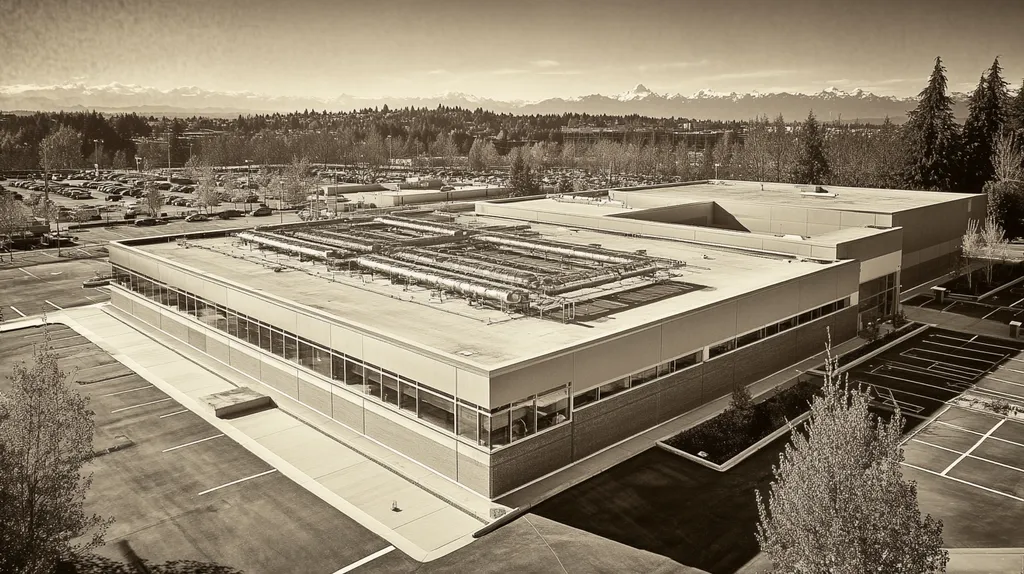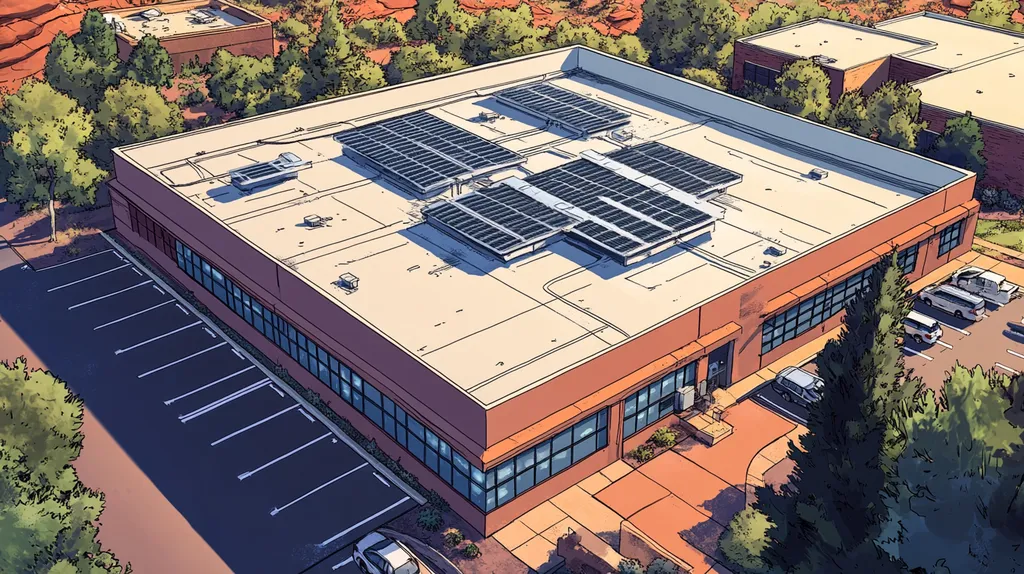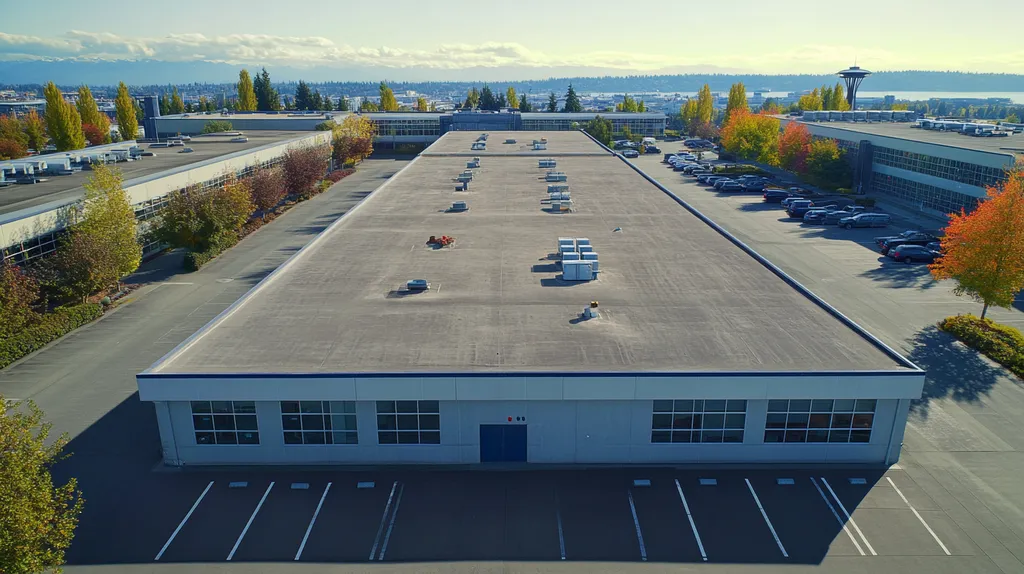The rising costs of climate control in commercial buildings have reached critical levels, with studies showing that inappropriate roofing choices can increase cooling expenses by up to 30% annually.
Temperature fluctuations significantly impact roofing material performance, yet many property owners continue following outdated installation practices that ignore these crucial thermal considerations.
This analysis examines how temperature influences commercial roof applications, revealing systemic issues in current practices while highlighting overlooked opportunities in modern roofing technologies that could dramatically improve building efficiency and sustainability.
SECTION 1: CURRENT PRACTICES
Choosing the right commercial roofing system is a critical decision that can have significant financial and environmental implications. For instance, research indicates that a darker roof can raise building temperatures by as much as 20 degrees Fahrenheit. Understanding the current practices in roofing materials, colors, and structural designs is vital for property owners and facility managers looking to optimize energy efficiency and sustainability while minimizing operational costs.
Common Roofing Materials Used
Commercial roofing systems predominantly feature materials like asphalt, EPDM, TPO, and PVC. Asphalt remains a popular choice due to its affordability, but it tends to hold heat, driving up cooling expenses. In contrast, single-ply systems such as TPO and PVC are increasingly preferred for their reflective capabilities, which can help combat the urban heat island effect. Decision-makers must carefully weigh the benefits and limitations of each material concerning their thermal impact.
Standard Roof Color Choices
Roof color is a crucial factor in managing building temperatures. Many commercial buildings still choose darker shades, which absorb heat and elevate thermal loads. On the other hand, lighter-colored roofs reflect sunlight, resulting in lower cooling demands and enhanced energy efficiency. Despite the evident benefits of reflective roofing, traditional darker colors continue to dominate the market, often leading to higher operational costs for businesses.
Typical Roof Structural Designs
Commercial roofs typically follow popular designs such as flat, sloped, or low-slope configurations. While flat roofs are economical, they can lead to water pooling and increased thermal accumulation. Sloped roofs encourage drainage but may limit the use of reflective surfaces. Consequently, design choices not only influence aesthetics but also play a crucial role in determining the thermal performance and energy efficiency of the structure. Rapid fluctuations in roof temperatures can even weaken the roofing membrane, resulting in cracks and gaps (source: National Gypsum).
SECTION 2: SYSTEMIC ISSUES
U.S. commercial buildings are responsible for around 35% of total energy consumption, which underscores the need for roofs that can handle temperature fluctuations effectively. As energy costs rise, outdated roofing practices that neglect the impact of temperature on energy efficiency lead to inflated operational expenses. This section delves into how these systemic issues hinder energy performance, overlook crucial climatic considerations, and result in insufficient maintenance practices.
Heat Absorption and Energy Costs
Heat absorption significantly affects energy costs associated with commercial roofs. Many traditional materials trap heat, causing buildings to overheat and rely heavily on air conditioning. For example, a dark membrane roof can increase interior temperatures by up to 20°F in the summer.
This rise in temperature forces facility managers to depend on HVAC systems more than necessary, driving up energy expenses and increasing wear on equipment. Over time, these costs can add up to thousands of dollars annually. Inefficient heat management also contributes to higher carbon emissions, opposing sustainability goals.
On the other hand, reflective roofing systems help counteract heat absorption. By redirecting solar energy, these systems can lower energy costs by as much as 30% over their lifespan. However, misconceptions about their effectiveness and initial costs hinder their broader adoption.
A comprehensive reevaluation of roofing materials and methods is essential for tackling heat absorption effectively. Investing in reflective solutions not only yields cost savings but also supports enhanced environmental stewardship within commercial facilities.
Limited Consideration of Climate
Variations in climate play a crucial role in roofing performance, yet many property owners overlook this vital aspect. Roofing systems intended for temperate conditions often falter in areas with extreme heat or cold. This lack of awareness can lead to early roof failures and costly repairs.
For instance, buildings in hot, arid climates experience thermal cycling, where the heat of the day and the coolness at night put unnecessary stress on roofing materials. Standard installations in these regions may not incorporate the flexibility required to endure these temperature swings.
Additionally, zones with heavy rainfall or snowfall require materials that can withstand moisture without degrading. Yet, property managers frequently adhere to conventional roofing approaches, mistakenly believing they are suitable for all climates, which can result in significant issues.
Tailoring roofing solutions to local climate conditions is essential. By implementing climate-appropriate designs, property owners can achieve longer-lasting roofs and reduced maintenance costs.
Inadequate Maintenance Practices
The neglect of proper maintenance practices is a key factor in roofing failures across commercial properties. Often, property managers fail to conduct regular inspections and upkeep, mistakenly assuming that new roofs will remain problem-free. In reality, even the best roofing systems need ongoing care.
Statistics indicate that 75% of premature roof failures are due to improper maintenance. Ignoring minor issues like clogged gutters or small leaks can escalate into expensive repairs or replacements. Regular maintenance is a critical strategy for preventing such scenarios, extending the lifespan of roofs.
Moreover, seasonal temperature fluctuations can worsen wear on roofing materials if not properly maintained. For example, in cold climates, ice dams can form if gutters are not cleared, resulting in leaks and potential structural damage.
A proactive maintenance schedule that takes seasonal temperature variations into account can significantly enhance a roof’s durability. By committing to routine inspections and repairs, property owners can greatly decrease overall costs and prolong the life of their roofing systems.
SECTION 3: MISSED OPPORTUNITIES
In today’s competitive landscape, many property owners miss out on transformative roofing innovations that can significantly boost energy efficiency and extend roof lifespans. Studies reveal that reflective roofing materials can cut energy consumption by up to 30% during peak heat. Yet, the industry clings to conventional materials that fail to maximize roofing performance. This section addresses three critical areas where opportunities for improvement are often overlooked: reflective materials, green roofs, and advanced roofing technologies.
Neglect of Reflective Materials
Reflective roofing materials play a vital role in reducing heat absorption during hotter months. These innovative materials can significantly lower roof temperatures by bouncing sunlight away, thereby cutting cooling costs substantially. Unfortunately, many industry stakeholders still opt for darker roofing options that absorb, rather than deflect, heat.
This outdated approach not only results in higher energy bills, especially over summer, but also inflates air conditioning costs for properties with traditional dark roofs. The lack of awareness about reflective materials’ benefits contributes to ongoing expenditures and operational inefficiencies.
Furthermore, some jurisdictions are implementing incentives and regulations to promote the use of reflective roofing for energy sustainability. Property owners who ignore these advancements may find themselves not only grappling with rising operational costs but also facing compliance challenges down the line.
Embracing reflective materials should be a top priority for property owners seeking to improve energy efficiency and sustainability. By failing to consider available options, stakeholders risk substantial cost savings and increased operational efficiency.
Overlooking Green Roof Benefits
Green roofs provide an exceptional sustainable solution that offers aesthetic appeal as well as significant environmental advantages. These living roofs help combat urban heat islands, enhance air quality, and manage stormwater efficiently. Yet, numerous commercial properties bypass this innovative option.
Research indicates that green roofs can significantly lower surface temperatures, which helps prolong the life of the roofing systems beneath. Their natural insulation properties lead to decreased energy costs for both heating and cooling. Though initial installation costs can be high, the long-term savings and benefits are noteworthy.
Moreover, green roofs contribute to urban biodiversity, ensuring greater resilience in the local ecosystem. As cities face mounting environmental challenges, the potential of green roofs remains underutilized—presenting a valuable missed opportunity for proactive property owners to champion sustainable initiatives in their areas.
By integrating green roofing solutions, property owners can not only enhance their buildings but also positively impact their local environments, boosting property values while aligning with broader sustainable development goals.
Ignoring Advanced Roofing Technologies
Advanced roofing technologies, such as cool-roof systems and energy-generating designs, are still underutilized in many commercial properties. Cool roofs are engineered to reflect more sunlight and absorb less heat, translating to improved energy efficiency and a reduced carbon footprint.
Additionally, incorporating solar panels into roofing systems allows buildings to generate renewable energy on-site, offsetting energy costs. However, traditional roofing approaches still dominate the market, primarily because decision-makers are reluctant to adopt these innovative solutions.
The potential for new technologies to drive down energy costs is immense. A commercial property investing in energy-efficient roofing technology could achieve a return on investment that matches or even exceeds that of more conventional materials.
As the market evolves, complacency toward advanced roofing technologies can leave property owners at a competitive disadvantage. The urgency to adopt these modern solutions is growing, with increased regulatory pressures and market expectations emphasizing the need for greener buildings.
SECTION 4: ROOT CAUSES
Understanding the root causes of temperature-related issues in commercial roofing is crucial for property owners. Misconceptions about the significance of solar reflectance can lead to increased energy costs and reduced roof longevity. Additionally, inadequate insulation and ventilation contribute to moisture build-up, threatening the structural integrity of roofs. Also, poorly designed roofs are often incapable of handling temperature fluctuations effectively. Addressing these issues is essential to improve roofing performance and sustainability.
Lack of Awareness on Solar Reflectance
Many property owners are unaware of how solar reflectance affects energy efficiency. Roofing materials with low reflectivity can absorb excessive heat, leading to inflated cooling costs during the warmer months. For example, a roof reflecting at least 30% of solar energy can reduce energy expenses by up to 20%.
In addition, elevated roof temperatures can accelerate material degradation, resulting in the need for more frequent repairs or replacements. Property owners should prioritize evaluating the solar reflectance index (SRI) of their roofing materials for effective long-term cost management.
Despite the clear advantages of reflective materials, many still opt for traditional dark roofing. This trend often stems from a lack of knowledge regarding better-performing alternatives suitable for warmer climates.
Moreover, the industry’s failure to integrate solar reflectance in roofing decisions affects not only individual buildings but also contributes to the urban heat island effect, exacerbating environmental challenges.
Insufficient Insulation and Ventilation
Inadequate insulation and ventilation are significant contributors to excessive thermal buildup in commercial roofs. Without sufficient insulation, heat can easily penetrate the building, forcing cooling systems to work harder. This not only increases energy costs but also raises the risk of system failure.
Poor ventilation can trap heat and moisture beneath the roof surface, leading to mold growth and structural damage. Ensuring adequate airflow is essential for maintaining the integrity and performance of commercial roofs.
Property managers must recognize that effective insulation and ventilation play crucial roles in moderating roof temperatures. Implementing strategies to address these elements can greatly enhance overall system efficiency.
Neglecting proper insulation and ventilation may result in expensive long-term consequences, making them critical factors in modern roofing practices.
Inadequate Roof Design Considerations
Many commercial roofs are designed without adequate consideration for temperature variations. This oversight can lead to material fatigue and structural compromise over time. A roof lacking necessary slopes or thermal break technologies may struggle to manage extreme temperature changes effectively.
Additionally, the design often neglects the benefits of integrating green roofing options, which can improve thermal regulation. Green roofs offer natural insulation and significantly reduce heat absorption, benefiting both the building and the environment.
Overlooking these design factors not only increases maintenance requirements but also accelerates the aging of roofing systems. Property owners must advocate for designs that prioritize temperature resilience as a fundamental criterion.
Addressing these design shortcomings is essential to ensure the long-term viability of commercial roofing systems, particularly in our current climate of increasing temperature fluctuations.
DATA DRIVEN EVIDENCE
Understanding how different roofing materials respond to temperature fluctuations is essential for property owners aiming to optimize energy efficiency and building longevity. Studies demonstrate that variations in roof type can create temperature differences exceeding 30 degrees Fahrenheit, influencing both energy expenses and the lifespan of roofing systems. This section will analyze temperature differences among roof types, the energy savings generated by cool roofs, and the significant role of roof design on indoor climate control.
Temperature Variations by Roof Type
The choice of roofing material can dramatically affect temperature control. For example, dark-colored roofs frequently reach temperatures above 160°F when exposed to sunlight, while white or reflective roofs can stay 30-50°F cooler. This difference not only elevates external temperatures but also intensifies cooling requirements within the building.
Modern systems, such as green or vegetative roofs, offer additional benefits by insulating against extreme temperatures. These roofs absorb solar radiation and facilitate evaporative cooling, which mitigates temperature swings. By selecting appropriate materials, property owners can enhance energy efficiency while extending the operational life of their roofs, decreasing the frequency of replacements.
Thorough evaluation of material temperature performance can guide informed decision-making. For instance, investments in cool roofing could yield substantial returns by lowering energy expenses. It is crucial to consider local climate and building orientation for optimal roofing performance.
Energy Savings from Cool Roofs
Cool roofs are engineered to reflect a larger portion of sunlight and absorb minimal heat compared to conventional roofs. According to the U.S. Department of Energy, these roofs can cut energy consumption by up to 25%, a key advantage during peak air conditioning months.
A commercial building with a flat white roof in an area with high temperatures could save thousands of dollars annually in cooling costs. Furthermore, cities that adopt cool roof technology can significantly lessen the urban heat island effect, leading to overall reductions in energy demand.
Additionally, cool roofs tend to have longer lifespans due to decreased thermal cycling and stress, resulting in lower repair and replacement costs over time. By opting for cooler roofing solutions, property owners can attain cost savings while enhancing sustainability in urban areas.
Impact of Roof Design on Interior Temperatures
The design of a roof is crucial for effective thermal performance within a building. Poor design can lead to excessive heat gain, placing undue strain on HVAC systems. Reflective roofing materials, combined with sufficient insulation, establish a protective barrier against heat, ensuring comfortable indoor conditions.
For instance, buildings equipped with sloped roofs benefit from improved airflow and ventilation, contributing to cooler interior spaces. Conversely, flat roofs often trap heat and demand more energy to achieve thermal comfort. This fundamental design decision can have significant effects on energy consumption and occupant satisfaction.
Incorporating advanced design features, like thermal breaks or strategically positioned skylights, also improves natural ventilation while minimizing heat capture. By prioritizing these considerations, property owners can cultivate energy-efficient environments, enhancing comfort and reducing utility costs.
SECTION 6: ALTERNATIVE SOLUTIONS
As temperatures continue to rise, relying on conventional roofing practices not only escalates energy expenses but also compounds maintenance challenges. The U.S. Department of Energy reports that nearly 30% of energy consumption in buildings is wasted. To tackle these pressing issues, property owners and facility managers must embrace modern roofing solutions that effectively address temperature challenges while optimizing building performance.
Implementing Cool Roof Technologies
Cool roof technologies are leading the way in the fight against heat absorption in commercial buildings. These innovative roofs utilize reflective materials that substantially reduce thermal mass, resulting in indoor temperature reductions. For instance, cool roofs can lower surface temperatures by up to 50 degrees Fahrenheit, significantly decreasing air conditioning costs.
Choosing to install cool roof systems is a strategic move for property owners. Resources from organizations like the Cool Roof Rating Council provide guidelines for selecting the best materials that fit specific building needs. Not only do these roofs improve indoor comfort, but they also help reduce the urban heat island effect, benefiting the wider community.
Incentives at both state and federal levels encourage the adoption of cool roofing solutions. Tax credits and rebates often accompany these investments, making eco-friendly transitions both financially viable and environmentally responsible.
Additionally, cool technologies enhance the lifespan of roofing materials. By minimizing thermal stress, roofs can remain in service longer, decreasing the frequency of costly replacements.
Integrating Green and Solar Roofs
Green and solar roof systems offer comprehensive solutions to contemporary roofing challenges. Green roofs, which are layered with vegetation, provide excellent insulation and contribute positively to air quality. They can decrease energy consumption by as much as 25%, leading to significant operational cost savings.
Moreover, green roofs effectively manage stormwater by absorbing rainwater and reducing runoff, a major concern in urban environments where water pollution is prevalent.
Solar roofs capture renewable energy, reinforcing sustainability initiatives. These roofs not only power the building but can also generate excess energy, allowing property owners to sell back to the grid in some instances.
By combining green and solar features, property owners maximize land usage while reaping both environmental and economic rewards. As the commercial real estate sector increasingly turns to renewable strategies, integrating these systems has become essential for forward-thinking property management.
Optimizing Roof Structure for Energy Efficiency
Structural optimization of commercial roofs can lead to significant improvements in energy efficiency. By carefully assessing aspects such as insulation thickness and ventilation, building owners can tailor roofing systems to lower cooling loads and enhance energy savings.
Advanced materials like spray foam insulation improve air sealing while providing substantial R-value. Selecting energy-efficient materials directly influences the overall thermal performance of a building, highlighting the importance of informed component choices.
Additionally, utilizing advanced technologies like thermal imaging can aid in identifying persistent issues and areas for improvement. Regular assessments ensure that property managers can make data-driven decisions, leading to optimal resource allocation.
Overall, investing in an optimized roof structure not only enhances resistance to temperature fluctuations but also protects interior spaces, ultimately extending the roof’s lifespan and performance.
The Bottom Line
With commercial buildings accounting for 35% of U.S. energy consumption, the impact of temperature on roofing systems can no longer be ignored.
Studies demonstrate that implementing temperature-conscious roofing solutions could reduce cooling costs by up to 30% while extending roof lifespans by 5-10 years.
The commercial roofing industry must shift from outdated practices to embrace cool roof technologies, green solutions, and advanced materials engineered for thermal performance.
Property owners who continue relying on traditional dark roofs and inadequate insulation face escalating energy costs, increased maintenance expenses, and potential regulatory compliance issues.
The evidence is clear: addressing temperature influence in commercial roofing is not just an environmental concern but a critical business imperative that directly impacts the bottom line.
FREQUENTLY ASKED QUESTIONS
Q. How does roof color affect a commercial roof’s temperature?
A. Roof color significantly impacts temperature management. Dark roofs absorb heat, potentially raising interior temperatures by up to 20°F in summer. Conversely, lighter-colored roofs reflect sunlight, reducing cooling requirements and promoting energy efficiency. Using reflective roofing materials can mitigate heat absorption, lowering energy costs and enhancing overall building performance.
Q. How do old roofing practices impact commercial roofs?
A. Outdated roofing practices often disregard temperature impact, leading to excessive energy consumption and increased operational costs. Many commercial roofs continue using traditional materials that absorb heat rather than reflecting it, which amplifies cooling needs. Transitioning to contemporary materials and techniques is crucial for improving energy efficiency and minimizing maintenance challenges.
Q. What are the benefits of using reflective roofing materials?
A. Reflective roofing materials offer significant benefits, including reduced heat absorption and lower energy costs. By reflecting sunlight, these materials help maintain cooler interior temperatures, often resulting in energy savings of up to 30%. Additionally, they can extend the lifespan of roofs by reducing thermal expansion and stress, leading to fewer repairs and replacements.
Q. Why is climate consideration important for commercial roofs?
A. Understanding local climate patterns is vital for selecting appropriate roofing systems. Roofs designed for specific climates perform better and last longer. Ignoring climatic factors can lead to premature roof failures and unnecessary expenses due to insufficient materials that may not withstand temperature extremes. Tailoring roofing choices to climate conditions ensures optimal performance and durability.
Q. What causes overheating in commercial roofs?
A. Overheating in commercial roofs is often caused by inadequate insulation, poor ventilation, and the choice of low-reflective materials. Without proper insulation, heat can easily penetrate buildings, while poor ventilation traps excessive heat. Choosing insulation that withstands temperature fluctuations and ensures adequate airflow is critical for managing heat effectively.
Q. How do green roofs contribute to energy efficiency?
A. Green roofs enhance energy efficiency by providing natural insulation and reducing heat absorption. The vegetation layer absorbs sunlight and helps moderate temperatures, leading to reduced energy costs. Additionally, these roofs manage stormwater effectively, promoting sustainability while improving air quality and enhancing the aesthetic appeal of buildings.
Q. What alternative roofing solutions can reduce energy costs?
A. Alternative solutions like cool roof technologies, green roofs, and solar panels can significantly reduce energy costs. Cool roofs reflect sunlight and minimize heat absorption, while green roofs improve insulation and manage stormwater. Solar panels generate renewable energy on-site, further decreasing reliance on conventional energy sources and enhancing sustainability initiatives.










